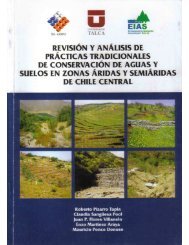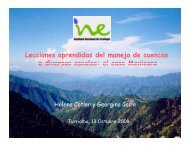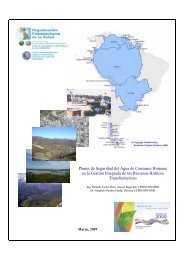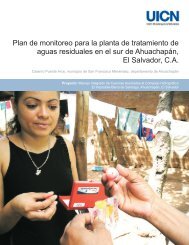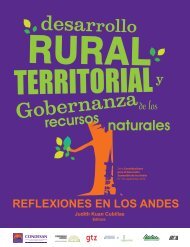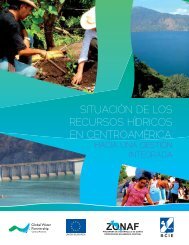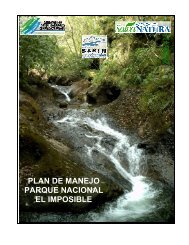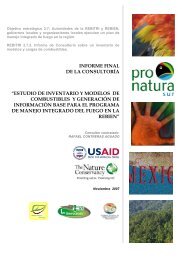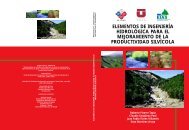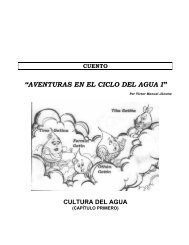Manual para la Gestión Integrada de Recursos HÃdricos ... - Cap-Net
Manual para la Gestión Integrada de Recursos HÃdricos ... - Cap-Net
Manual para la Gestión Integrada de Recursos HÃdricos ... - Cap-Net
Create successful ePaper yourself
Turn your PDF publications into a flip-book with our unique Google optimized e-Paper software.
CUADROS, EJEMPLOS & FIGURAS<br />
CUADROS, EJEMPLOS & FIGURAS<br />
Cuadro 1.A Cuencas transfronterizas en los cinco continentes . . . . . . . . . . . . . . . . . . . . . . . . . . . . . . . . .10<br />
Cuadro 2.A El ciclo <strong>de</strong> gestión <strong>de</strong> <strong>la</strong> p<strong>la</strong>nificación e implementación, basado en el aprendizaje<br />
mediante <strong>la</strong> práctica . . . . . . . . . . . . . . . . . . . . . . . . . . . . . . . . . . . . . . . . . . . . . . . . . . . . . . . . . . .19<br />
Cuadro 2.B Marco <strong>para</strong> <strong>la</strong> gestión <strong>de</strong> cuencas . . . . . . . . . . . . . . . . . . . . . . . . . . . . . . . . . . . . . . . . . . . . . . .22<br />
Cuadro 3.A Leyes y políticas en <strong>la</strong> gestión <strong>de</strong> cuencas . . . . . . . . . . . . . . . . . . . . . . . . . . . . . . . . . . . . . . . .30<br />
Cuadro 3.B Las tres dimensiones <strong>de</strong> los marcos <strong>para</strong> <strong>la</strong> gestión <strong>de</strong>l agua . . . . . . . . . . . . . . . . . . . . . . . .31<br />
Cuadro 4.A Asignación <strong>de</strong> <strong>la</strong>s responsabilida<strong>de</strong>s <strong>de</strong> gestión y regu<strong>la</strong>ción <strong>de</strong>l agua y <strong>de</strong> provisión<br />
<strong>de</strong> servicios hídricos . . . . . . . . . . . . . . . . . . . . . . . . . . . . . . . . . . . . . . . . . . . . . . . . . . . . . . . . . .35<br />
Cuadro 4.B Principales funciones <strong>de</strong> los organismos <strong>de</strong> cuenca . . . . . . . . . . . . . . . . . . . . . . . . . . . . . . . .37<br />
Cuadro 4.C Organización <strong>de</strong> <strong>la</strong> gestión <strong>de</strong>l agua en <strong>la</strong>s cuencas: algunas com<strong>para</strong>ciones<br />
internacionales . . . . . . . . . . . . . . . . . . . . . . . . . . . . . . . . . . . . . . . . . . . . . . . . . . . . . . . . . . . . . . .49<br />
Cuadro 6.A Puntos c<strong>la</strong>ve a tener en cuenta <strong>para</strong> <strong>la</strong> participación <strong>de</strong> los diferentes actores . . . . . . . . . .65<br />
Cuadro 6.B Participación local en <strong>la</strong> gestión <strong>de</strong> cuencas . . . . . . . . . . . . . . . . . . . . . . . . . . . . . . . . . . . . . .66<br />
Cuadro 7.A C<strong>la</strong>ves <strong>para</strong> e<strong>la</strong>borar una estrategia <strong>de</strong> gestión <strong>de</strong> cuencas exitosa . . . . . . . . . . . . . . . . . . .70<br />
Cuadro 7.B Establecimiento <strong>de</strong> priorida<strong>de</strong>s, evaluación y c<strong>la</strong>sificación <strong>de</strong> problemas re<strong>la</strong>cionados<br />
con los recursos hídricos . . . . . . . . . . . . . . . . . . . . . . . . . . . . . . . . . . . . . . . . . . . . . . . . . . . . . .72<br />
Cuadro 7.C Directrices <strong>para</strong> <strong>la</strong> distribución <strong>de</strong> costos y beneficios . . . . . . . . . . . . . . . . . . . . . . . . . . . . . . .76<br />
Cuadro 7.D Evaluación <strong>de</strong> los riesgos p<strong>la</strong>nteados por el cambio climático . . . . . . . . . . . . . . . . . . . . . . .78<br />
Cuadro 7.E Estrategias <strong>para</strong> minimizar riesgos . . . . . . . . . . . . . . . . . . . . . . . . . . . . . . . . . . . . . . . . . . . . . . .78<br />
Cuadro 8.A Principios <strong>de</strong> diseño y principales componentes <strong>de</strong> un p<strong>la</strong>n <strong>de</strong> gestión <strong>de</strong> cuencas . . . . .80<br />
Cuadro 8.B Directrices <strong>para</strong> coordinar <strong>la</strong> gestión <strong>de</strong> una cuenca . . . . . . . . . . . . . . . . . . . . . . . . . . . . . . . .82<br />
Cuadro 8.C Herramientas <strong>de</strong> coordinación <strong>para</strong> los organismos <strong>de</strong> cuenca . . . . . . . . . . . . . . . . . . . . . . .83<br />
Cuadro 9.A Buenas prácticas en los sistemas <strong>de</strong> información y monitoreo <strong>de</strong> cuencas . . . . . . . . . . . . .88<br />
Cuadro 9.B Características <strong>de</strong> un sistema <strong>de</strong> información <strong>de</strong> cuenca . . . . . . . . . . . . . . . . . . . . . . . . . . . .89<br />
Cuadro 9.C Tipos <strong>de</strong> datos en un inventario <strong>de</strong> información <strong>de</strong> cuenca . . . . . . . . . . . . . . . . . . . . . . . . . .93<br />
Cuadro 9.D Preguntas c<strong>la</strong>ve que <strong>de</strong>ben formu<strong>la</strong>rse al momento <strong>de</strong> crear un sistema <strong>de</strong> monitoreo . . .98<br />
Ejemplo 1.1 Cuenca <strong>de</strong>l Río Senegal: <strong>la</strong> variabilidad climática exacerba <strong>la</strong> escasez <strong>de</strong> agua . . . . . . . .11<br />
Ejemplo 1.2 Cuencas <strong>de</strong>l Nilo, Lago Chad y Níger: visiones compartidas . . . . . . . . . . . . . . . . . . . . . . . .13<br />
Ejemplo 1.3 África: incorporación <strong>de</strong> los principios <strong>de</strong> GIRH a <strong>la</strong>s políticas nacionales . . . . . . . . . . . .14<br />
Ejemplo 1.4 Brasil: nueva política y estructura <strong>para</strong> <strong>la</strong> gestión <strong>de</strong>l agua . . . . . . . . . . . . . . . . . . . . . . . . .15<br />
Ejemplo 1.5 Asociación <strong>de</strong>l Río Amarillo <strong>de</strong> GWP China: GIRH a nivel <strong>de</strong> cuenca hidrográfica . . . . . . .16<br />
Ejemplo 2.1 Cuenca <strong>de</strong>l Volta: aplicación <strong>de</strong> <strong>la</strong> gestión integrada <strong>de</strong> recursos hídricos . . . . . . . . . . . .18<br />
Ejemplo 2.2 Cuenca <strong>de</strong>l Río Mekong: introducción <strong>de</strong> GIRH a nivel local, <strong>de</strong> implementación<br />
y <strong>de</strong> políticas . . . . . . . . . . . . . . . . . . . . . . . . . . . . . . . . . . . . . . . . . . . . . . . . . . . . . . . . . . . . . . .20<br />
Ejemplo 2.3 India: aplicación <strong>de</strong> <strong>la</strong> gestión integrada <strong>de</strong> recursos hídricos a nivel <strong>de</strong> distrito . . . . . . .21<br />
Ejemplo 2.4 Penínsu<strong>la</strong> <strong>de</strong> Yucatán, México: integración <strong>de</strong> <strong>la</strong> gestión <strong>de</strong> los recursos <strong>de</strong> agua<br />
subterránea a nivel regional . . . . . . . . . . . . . . . . . . . . . . . . . . . . . . . . . . . . . . . . . . . . . . . . . .21<br />
Ejemplo 2.5 Francia: comités locales <strong>de</strong>l agua y comités nacionales <strong>de</strong> cuencas hidrográficas . . . . .23<br />
Ejemplo 3.1 Cuenca Matanza–Riachuelo, Buenos Aires, Argentina: <strong>la</strong> importancia <strong>de</strong> <strong>la</strong> voluntad<br />
política . . . . . . . . . . . . . . . . . . . . . . . . . . . . . . . . . . . . . . . . . . . . . . . . . . . . . . . . . . . . . . . . . . . .26<br />
Ejemplo 3.2 Cuenca <strong>de</strong>l Río Orange–Senqu: hoja <strong>de</strong> ruta <strong>para</strong> fomentar el diálogo sobre gestión<br />
<strong>de</strong> cuencas entre usuarios <strong>de</strong>l agua . . . . . . . . . . . . . . . . . . . . . . . . . . . . . . . . . . . . . . . . . . . .27<br />
Ejemplo 3.3 Cuenca <strong>de</strong>l Tisza: <strong>la</strong> <strong>la</strong>rga trayectoria en cooperación abre el camino hacia el diálogo<br />
entre países sobre gestión <strong>de</strong> cuencas . . . . . . . . . . . . . . . . . . . . . . . . . . . . . . . . . . . . . . . . .28<br />
Ejemplo 3.4 España y Portugal: extensa trayectoria en el diálogo sobre cuencas compartidas . . . . . . .28<br />
Ejemplo 3.5 India: Tribunal <strong>de</strong> Disputas <strong>de</strong> Agua <strong>de</strong> Narmada . . . . . . . . . . . . . . . . . . . . . . . . . . . . . . . . .29<br />
Ejemplo 3.6 Organismo <strong>de</strong> <strong>la</strong> Cuenca <strong>de</strong>l Río Oum Er Rbia, Marruecos: marco jurídico . . . . . . . . . . . .30<br />
Ejemplo 3.7 Cuenca <strong>de</strong>l Volta: establecimiento <strong>de</strong> un marco <strong>de</strong> gestión <strong>de</strong>l agua . . . . . . . . . . . . . . . .31<br />
Ejemplo 4.1 Québec: misión y mandatos <strong>de</strong> los organismos <strong>de</strong> cuenca . . . . . . . . . . . . . . . . . . . . . . . . .36<br />
Ejemplo 4.2 Comisión <strong>de</strong> <strong>Recursos</strong> Hídricos <strong>de</strong> Changjiang, China: misión y funciones . . . . . . . . . . . .38<br />
Ejemplo 4.3 Organismo <strong>de</strong> <strong>la</strong> cuenca <strong>de</strong>l Congo: evolución . . . . . . . . . . . . . . . . . . . . . . . . . . . . . . . . . . .39<br />
Ejemplo 4.4 Autoridad <strong>de</strong> Mahaweli, Sri Lanka: evolución y transformación <strong>de</strong> su rol . . . . . . . . . . . . .39<br />
Ejemplo 4.5 Organización <strong>para</strong> el Aprovechamiento <strong>de</strong>l Río Senegal: evolución . . . . . . . . . . . . . . . . . .40<br />
Ejemplo 4.6 Organización <strong>para</strong> el Aprovechamiento <strong>de</strong>l Río Gambia: lecciones aportadas por<br />
su evolución . . . . . . . . . . . . . . . . . . . . . . . . . . . . . . . . . . . . . . . . . . . . . . . . . . . . . . . . . . . . . . .41<br />
MANUAL PARA LA GESTIÓN INTEGRADA DE RECURSOS HÍDRICOS EN CUENCAS<br />
4<br />
www.inbo-news.org | www.gwpforum.org



